img029
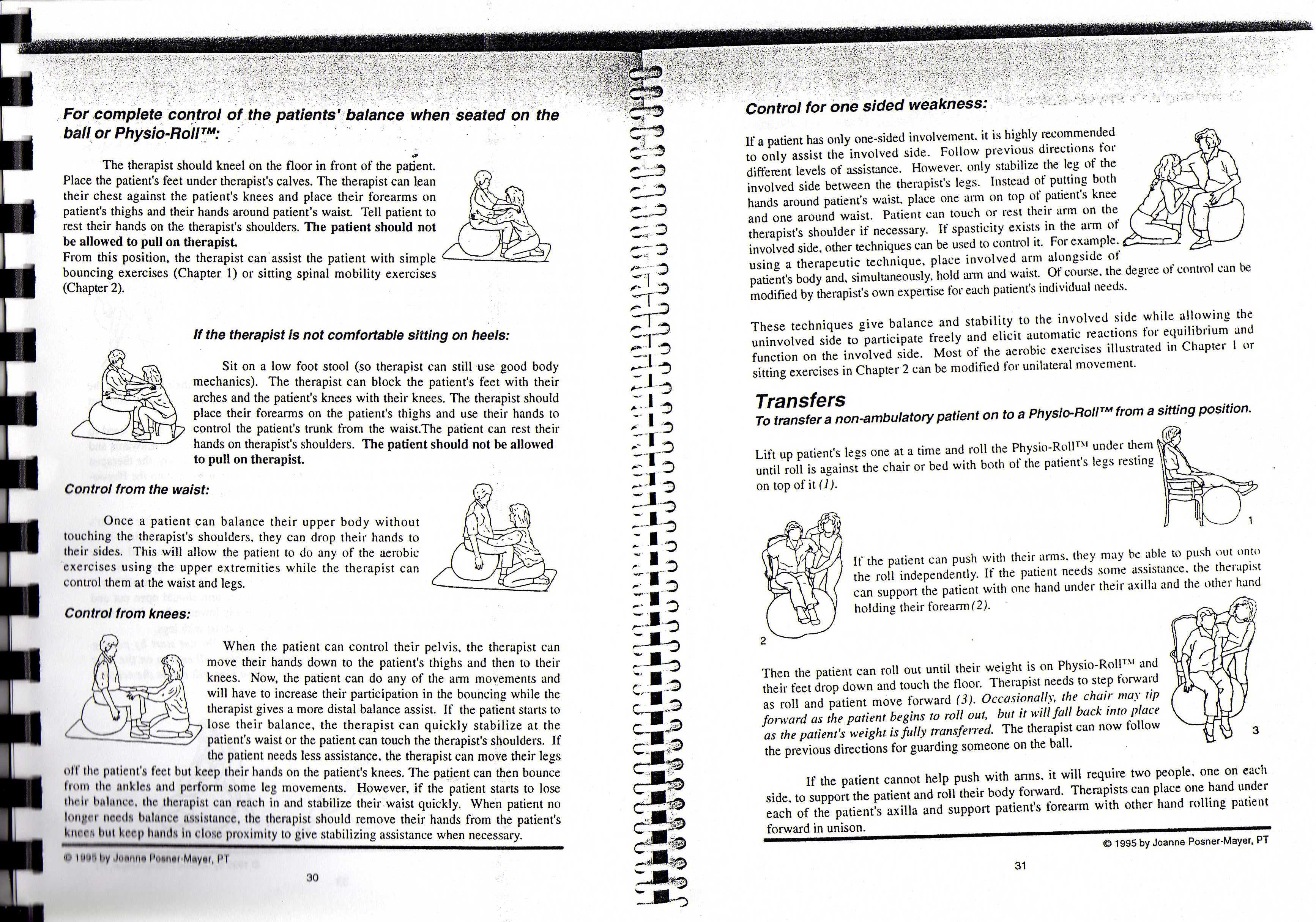
For complete control of the patients' balance when seated on the bali or Physio-Roll™:

The therapist should kneel on the floor in front of the patient.
Place the patienfs feet under therapisfs calves. The therapist can lean their chest against the patienfs knees and place their forearms on patienfs thighs and their hands around patienfs waist. Tell patient to rest their hands on the therapisfs shoulders. The patient should not be allowed to puli on therapist.
From this position, the therapist can assist the patient with simple bouncing exercises (Chapter 1) or sitting spinał mobility exercises (Chapter 2).
If the therapist is not comfortable sitting on heeis:
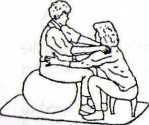
Sit on a Iow foot stool (so therapist can still use good body mechanics). The therapist can błock the patienfs feet with their arches and the patienfs knees with their knees. The therapist should place their forearms on the patienfs thighs and use their hands to control the patienfs trunk from the waist.The patient can rest their hands on therapisfs shoulders. The patient should not be allowed to puli on therapist.

Control from the waist:
Once a patient can balance their upper body without touching the therapisfs shoulders. they can drop their hands to their sides. This will allow the patient to do any of the aerobic exercises using the upper extremities while the therapist can control them at the waist and legs.
Control from knees:
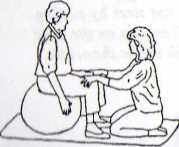
When the patient can control their pelvis, the therapist can move their hands down to the patienfs thighs and then to their knees. Now, the patient can do any of the arm movements and will have to increase their participation in the bouncing while the therapist gives a morę distal balance assist. If the patient starts to , lose their balance, the therapist can quickly stabilize at the patienfs waist or the patient can touch the therapisfs shoulders. If the patient needs less assistance. the therapist can move their legs uli llir patienfs leci but keep their hands on the patienfs knees. The patient can then bounce from llir nnklc.s and pcrform some leg movements. However, if the patient starts to lose llirii balance, (lic therapist can reach in and stabilize their waist quickly. When patient no lunyri needs balance assislaiu e. the therapist should remove their hands from the patienfs knees bill keep hands in i lu.se proximlty to give stabilizing assistance when necessary.
Ci I |»y Imtiiiin 1'imnar Mnyoi, I' I
ControI for one sided weakness:
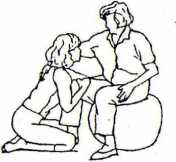
If a patiem has only one-sided involvement. it i.s highly recommended to only assist the involved side. Follow previous directions for difterent levels of assistance. However. only stabilize the leg of the involved side between the therapist's legs. Instead of putting both hands around patient's waist, place one arm on top of patienfs knee and one around waist. Patient ean touch or rest their arm on the therapist's shoulder if necessary. If spasticity exists in the arm of involved side. other techniques can be used to contro! it. For example. using a therapeutic techniąue, place involved arm alongside of patient's body and, simultaneously, hołd arm and waist. Of course. the degree of control can be modified by therapisfs own experti.se foreach patient's individual needs.
These techniąues give balance and stability to the involved side while allowing the uninvolved side to participate freely and elicit automatic reactions for equilibrium and function on the involved side. Most of the aerobic exercises illustrated in Chapter 1 or sitting exercises in Chapter 2 can be modified for unilateral movement.
Transfers
To transfer a non-ambulatory patient on to a Physio-Roll™ from a sitting position.
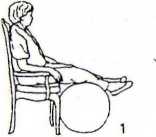
Lift up patient's legs one at a time and roli the Physio-Roll™ under them until roli is against the chair or bed with both of the patient's legs resting on top of it f /
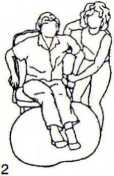
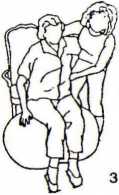
If the patient can push with their arms. they may be able to push out onto the roli independently. If the patient needs some assistance. the therapist can support the patient with one hand under their axilla and the other hand holding their forearmf2L
Then the patient can roli out until their weight is on Physio-Roll7'1 and their feet drop down and touch the floor. Therapist needs to step forward as roli and patient move forward (3). Occasionally, the chair may tip forward as the patient begins to roii out, but it will fali back into place as the patient's weight is fttlly transferred. The therapist can now follow the previous directions for guarding someone on the bali.
If the patient cannot help push with arms, it will require two people, one on each side. to support the patient and roli their body forward. Therapists can place one hand under each of the patienfs axilla and support patient's forearm with other hand rolling patient forward in unison.
© 1995 by Joannę Posner-Mayer. PT
Wyszukiwarka
Podobne podstrony:
45713 tvpreachers TV Preachers +3 for dirnce controI of the Morał Minority. Power: 3 Resisfcance: 6&
mbs 027 MY BREATHING SYSTEM sucked in. For persons who lind it very difficult to acquire tłiis contr
IMAG0362 (6) Central control of the Amygda/a: main limbie . Ł,« region for emotion
00150 D9acbde9d435381a2e9b8d77b152fd5 151 Optimization and Sensitmty Analysis account for over 90%
Section DCompletionReturn of permit On completion of work, the issued copies of the permit should be
3) Synchronization Burst (SB): It is used for frame synchronization of the mobile.
IMG?03 paszport Ważny na wszystkie kraje świata THIS PAS SPORT IS VALfD FOR ALL COUlMTRfES OF T
File0008 Hi! I m Martin l m 17 years old and Tm looking for e-mail friends of the same age from
NOTIFICATIONThe rariaad admission Schedule for Postgraduate Courses of the University of Delhi for t
więcej podobnych podstron